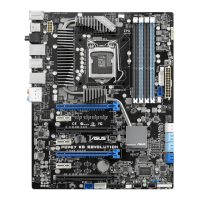You may install 1GB, 2GB, 4GB, 8GB unbuffered and non-ECC DDR3 DIMMs into
the DIMM sockets.
• You may install varying memory sizes in Channel A and Channel B. The
system maps the total size of the lower-sized channel for the dual-channel
configuration. Any excess memory from the higher-sized channel is then
mapped for single-channel operation.
• According to Intel spec definition, DDR3-1600 is supported for one DIMM
per channel only. ASUS exclusively provides two DDR3-1600 DIMM
support for each memory channel.
• According to Intel CPU spec, DIMM voltage below 1.65V is recommended
to protect the CPU.
• According to Intel CPU spec, CPUs with a core frequency of 2.66G support
the maximum DIMM frequency of up to DDR3-1333. To use DIMMs of a
higher frequency with a 2.66G CPU, enable the DRAM O.C. Profile feature
in BIOS. Refer to section 3.5.1 Ai Overclock Tuner for details.
• Always install DIMMs with the same CAS latency. For optimum
compatibility, we recommend that you obtain memory modules from the
same vendor.
• Due to the memory address limitation on 32-bit Windows OS, when you
install 4GB or more memory on the motherboard, the actual usable memory
for the OS can be about 3GB or less. For effective use of memory, we
recommend that you do any of the following:
- Use a maximum of 3GB system memory if you are using a 32-bit
Windows OS.
- Install a 64-bit Windows OS when you want to install 4GB or more on the
motherboard.
For more details, refer to the Microsoft® support site at
http://support.microsoft.com/kb/929605/en-us.
• This motherboard does not support DIMMs made up of 512Mb (64MB)
chips or less (Memory chip capacity counts in Megabit, 8 Megabit/Mb = 1
Megabyte/MB).
• The default memory operation frequency is dependent on its Serial
Presence Detect (SPD), which is the standard way of accessing information
from a memory module. Under the default state, some memory modules
for overclocking may operate at a lower frequency than the vendor-marked
value. To operate at the vendor-marked or at a higher frequency, refer to
section 3.4 Ai Tweaker menu for manual memory frequency adjustment.
• For system stability, use a more efficient memory cooling system to support
a full memory load (4 DIMMs) or overclocking condition.
2-6 Chapter 2: Hardware information

